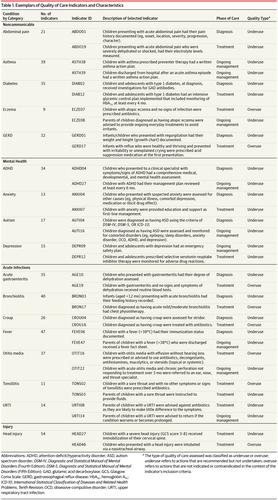Our official English website, www.x-mol.net, welcomes your
feedback! (Note: you will need to create a separate account there.)
Quality of Health Care for Children in Australia, 2012-2013
JAMA ( IF 63.1 ) Pub Date : 2018-03-20 , DOI: 10.1001/jama.2018.0162 Jeffrey Braithwaite 1 , Peter D Hibbert 1, 2, 3 , Adam Jaffe 4, 5 , Les White 1, 6, 7 , Christopher T Cowell 8, 9 , Mark F Harris 10 , William B Runciman 1, 2, 3 , Andrew R Hallahan 11 , Gavin Wheaton 12 , Helena M Williams 13, 14, 15 , Elisabeth Murphy 16 , Charlotte J Molloy 1, 2 , Louise K Wiles 1, 2 , Shanthi Ramanathan 1, 2 , Gaston Arnolda 1 , Hsuen P Ting 1 , Tamara D Hooper 1, 2 , Natalie Szabo 1, 2 , John G Wakefield 17 , Clifford F Hughes 1, 18 , Annette Schmiede 19 , Chris Dalton 19 , Sarah Dalton 7, 20, 21 , Joanna Holt 1 , Liam Donaldson 22, 23 , Ed Kelley 23 , Richard Lilford 24 , Peter Lachman 18 , Stephen Muething 25
JAMA ( IF 63.1 ) Pub Date : 2018-03-20 , DOI: 10.1001/jama.2018.0162 Jeffrey Braithwaite 1 , Peter D Hibbert 1, 2, 3 , Adam Jaffe 4, 5 , Les White 1, 6, 7 , Christopher T Cowell 8, 9 , Mark F Harris 10 , William B Runciman 1, 2, 3 , Andrew R Hallahan 11 , Gavin Wheaton 12 , Helena M Williams 13, 14, 15 , Elisabeth Murphy 16 , Charlotte J Molloy 1, 2 , Louise K Wiles 1, 2 , Shanthi Ramanathan 1, 2 , Gaston Arnolda 1 , Hsuen P Ting 1 , Tamara D Hooper 1, 2 , Natalie Szabo 1, 2 , John G Wakefield 17 , Clifford F Hughes 1, 18 , Annette Schmiede 19 , Chris Dalton 19 , Sarah Dalton 7, 20, 21 , Joanna Holt 1 , Liam Donaldson 22, 23 , Ed Kelley 23 , Richard Lilford 24 , Peter Lachman 18 , Stephen Muething 25
Affiliation

|
Importance The quality of routine care for children is rarely assessed, and then usually in single settings or for single clinical conditions. Objective To estimate the quality of health care for children in Australia in inpatient and ambulatory health care settings. Design, Setting, and Participants Multistage stratified sample with medical record review to assess adherence with quality indicators extracted from clinical practice guidelines for 17 common, high-burden clinical conditions (noncommunicable [n = 5], mental health [n = 4], acute infection [n = 7], and injury [n = 1]), such as asthma, attention-deficit/hyperactivity disorder, tonsillitis, and head injury. For these 17 conditions, 479 quality indicators were identified, with the number varying by condition, ranging from 9 for eczema to 54 for head injury. Four hundred medical records were targeted for sampling for each of 15 conditions while 267 records were targeted for anxiety and 133 for depression. Within each selected medical record, all visits for the 17 targeted conditions were identified, and separate quality assessments made for each. Care was evaluated for 6689 children 15 years of age and younger who had 15 240 visits to emergency departments, for inpatient admissions, or to pediatricians and general practitioners in selected urban and rural locations in 3 Australian states. These visits generated 160 202 quality indicator assessments. Exposures Quality indicators were identified through a systematic search of local and international guidelines. Individual indicators were extracted from guidelines and assessed using a 2-stage Delphi process. Main Outcomes and Measures Quality of care for each clinical condition and overall. Results Of 6689 children with surveyed medical records, 53.6% were aged 0 to 4 years and 55.5% were male. Adherence to quality of care indicators was estimated at 59.8% (95% CI, 57.5%-62.0%; n = 160 202) across the 17 conditions, ranging from a high of 88.8% (95% CI, 83.0%-93.1%; n = 2638) for autism to a low of 43.5% (95% CI, 36.8%-50.4%; n = 2354) for tonsillitis. The mean adherence by condition category was estimated as 60.5% (95% CI, 57.2%-63.8%; n = 41 265) for noncommunicable conditions (range, 52.8%-75.8%); 82.4% (95% CI, 79.0%-85.5%; n = 14 622) for mental health conditions (range, 71.5%-88.8%); 56.3% (95% CI, 53.2%-59.4%; n = 94 037) for acute infections (range, 43.5%-69.8%); and 78.3% (95% CI, 75.1%-81.2%; n = 10 278) for injury. Conclusions and Relevance Among a sample of children receiving care in Australia in 2012-2013, the overall prevalence of adherence to quality of care indicators for important conditions was not high. For many of these conditions, the quality of care may be inadequate.
中文翻译:

2012-2013 年澳大利亚儿童医疗保健质量
重要性 很少对儿童常规护理的质量进行评估,然后通常在单一环境或单一临床条件下进行评估。目的 评估澳大利亚住院和门诊医疗机构中儿童的医疗保健质量。设计、设置和参与者 带有病历审查的多阶段分层样本,以评估对 17 种常见、高负担临床状况(非传染性 [n = 5]、心理健康 [n = 4]、急性感染 [n = 7] 和损伤 [n = 1]),例如哮喘、注意力缺陷/多动障碍、扁桃体炎和头部受伤。对于这 17 种情况,确定了 479 项质量指标,数量因情况而异,从湿疹的 9 项到头部受伤的 54 项不等。400 份医疗记录针对 15 种疾病中的每一种进行抽样,而 267 份记录针对焦虑症,133 份针对抑郁症。在每个选定的医疗记录中,确定了 17 种目标疾病的所有就诊,并对每种疾病进行单独的质量评估。在澳大利亚 3 个州的选定城市和农村地区,对 6689 名 15 岁及以下儿童进行了 15240 次急诊、住院治疗或儿科医生和全科医生的护理评估。这些访问产生了 160 202 项质量指标评估。暴露 质量指标是通过系统搜索当地和国际指南确定的。从指南中提取个别指标,并使用两阶段德尔菲法进行评估。主要结果和措施 每种临床状况和整体的护理质量。结果 6689名有调查病历的儿童中,0~4岁占53.6%,男性占55.5%。在 17 种情况下,对护理质量指标的依从率估计为 59.8%(95% CI,57.5%-62.0%;n = 160 202),最高可达 88.8%(95% CI,83.0%-93.1%; n = 2638) 自闭症的低至 43.5% (95% CI, 36.8%-50.4%; n = 2354) 用于扁桃体炎。对于非传染性疾病(范围,52.8%-75.8%),按疾病类别划分的平均依从性估计为 60.5%(95% CI,57.2%-63.8%;n = 41 265);82.4% (95% CI, 79.0%-85.5%; n = 14 622) 用于精神健康状况(范围,71.5%-88.8%);56.3%(95% CI,53.2%-59.4%;n = 94 037)用于急性感染(范围,43.5%-69.8%);78.3% (95% CI, 75.1%-81.2%; n = 10 278) 受伤。结论和相关性 在 2012-2013 年在澳大利亚接受护理的儿童样本中,对重要疾病护理质量指标的总体依从率不高。对于其中许多情况,护理质量可能不足。
更新日期:2018-03-20
中文翻译:

2012-2013 年澳大利亚儿童医疗保健质量
重要性 很少对儿童常规护理的质量进行评估,然后通常在单一环境或单一临床条件下进行评估。目的 评估澳大利亚住院和门诊医疗机构中儿童的医疗保健质量。设计、设置和参与者 带有病历审查的多阶段分层样本,以评估对 17 种常见、高负担临床状况(非传染性 [n = 5]、心理健康 [n = 4]、急性感染 [n = 7] 和损伤 [n = 1]),例如哮喘、注意力缺陷/多动障碍、扁桃体炎和头部受伤。对于这 17 种情况,确定了 479 项质量指标,数量因情况而异,从湿疹的 9 项到头部受伤的 54 项不等。400 份医疗记录针对 15 种疾病中的每一种进行抽样,而 267 份记录针对焦虑症,133 份针对抑郁症。在每个选定的医疗记录中,确定了 17 种目标疾病的所有就诊,并对每种疾病进行单独的质量评估。在澳大利亚 3 个州的选定城市和农村地区,对 6689 名 15 岁及以下儿童进行了 15240 次急诊、住院治疗或儿科医生和全科医生的护理评估。这些访问产生了 160 202 项质量指标评估。暴露 质量指标是通过系统搜索当地和国际指南确定的。从指南中提取个别指标,并使用两阶段德尔菲法进行评估。主要结果和措施 每种临床状况和整体的护理质量。结果 6689名有调查病历的儿童中,0~4岁占53.6%,男性占55.5%。在 17 种情况下,对护理质量指标的依从率估计为 59.8%(95% CI,57.5%-62.0%;n = 160 202),最高可达 88.8%(95% CI,83.0%-93.1%; n = 2638) 自闭症的低至 43.5% (95% CI, 36.8%-50.4%; n = 2354) 用于扁桃体炎。对于非传染性疾病(范围,52.8%-75.8%),按疾病类别划分的平均依从性估计为 60.5%(95% CI,57.2%-63.8%;n = 41 265);82.4% (95% CI, 79.0%-85.5%; n = 14 622) 用于精神健康状况(范围,71.5%-88.8%);56.3%(95% CI,53.2%-59.4%;n = 94 037)用于急性感染(范围,43.5%-69.8%);78.3% (95% CI, 75.1%-81.2%; n = 10 278) 受伤。结论和相关性 在 2012-2013 年在澳大利亚接受护理的儿童样本中,对重要疾病护理质量指标的总体依从率不高。对于其中许多情况,护理质量可能不足。









































 京公网安备 11010802027423号
京公网安备 11010802027423号